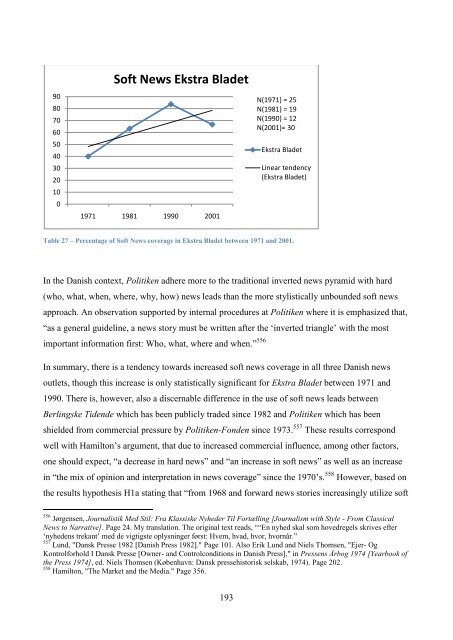The Jeremiad Over Journalism
The Jeremiad Over Journalism
The Jeremiad Over Journalism
You also want an ePaper? Increase the reach of your titles
YUMPU automatically turns print PDFs into web optimized ePapers that Google loves.
90<br />
80<br />
70<br />
60<br />
50<br />
40<br />
30<br />
20<br />
10<br />
0<br />
Soft News Ekstra Bladet<br />
1971 1981 1990 2001<br />
Table 27 – Percentage of Soft News coverage in Ekstra Bladet between 1971 and 2001.<br />
In the Danish context, Politiken adhere more to the traditional inverted news pyramid with hard<br />
(who, what, when, where, why, how) news leads than the more stylistically unbounded soft news<br />
approach. An observation supported by internal procedures at Politiken where it is emphasized that,<br />
―as a general guideline, a news story must be written after the ‗inverted triangle‘ with the most<br />
important information first: Who, what, where and when.‖ 556<br />
In summary, there is a tendency towards increased soft news coverage in all three Danish news<br />
outlets, though this increase is only statistically significant for Ekstra Bladet between 1971 and<br />
1990. <strong>The</strong>re is, however, also a discernable difference in the use of soft news leads between<br />
Berlingske Tidende which has been publicly traded since 1982 and Politiken which has been<br />
shielded from commercial pressure by Politiken-Fonden since 1973. 557 <strong>The</strong>se results correspond<br />
well with Hamilton‘s argument, that due to increased commercial influence, among other factors,<br />
one should expect, ―a decrease in hard news‖ and ―an increase in soft news‖ as well as an increase<br />
in ―the mix of opinion and interpretation in news coverage‖ since the 1970‘s. 558 However, based on<br />
the results hypothesis H1a stating that ―from 1968 and forward news stories increasingly utilize soft<br />
556 Jørgensen, Journalistik Med Stil: Fra Klassiske Nyheder Til Fortælling [<strong>Journalism</strong> with Style - From Classical<br />
News to Narrative]. Page 24. My translation. <strong>The</strong> original text reads, ――En nyhed skal som hovedregels skrives efter<br />
‗nyhedens trekant‘ med de vigtigste oplysninger først: Hvem, hvad, hvor, hvornår.‖<br />
557 Lund, "Dansk Presse 1982 [Danish Press 1982]." Page 101. Also Erik Lund and Niels Thomsen, "Ejer- Og<br />
Kontrolforhold I Dansk Presse [Owner- and Controlconditions in Danish Press]," in Pressens Årbog 1974 [Yearbook of<br />
the Press 1974], ed. Niels Thomsen (København: Dansk pressehistorisk selskab, 1974). Page 202.<br />
558 Hamilton, "<strong>The</strong> Market and the Media." Page 356.<br />
193<br />
N(1971) = 25<br />
N(1981) = 19<br />
N(1990) = 12<br />
N(2001)= 30<br />
Ekstra Bladet<br />
Linear tendency<br />
(Ekstra Bladet)
















